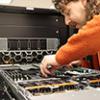This summer middle school students from across the state attended the Ohio Supercomputer Center’s (OSC) Youth Watershed Summer Institute, which offered students the opportunity to collect and analyze data from a local creek, create their own watersheds and learn fundamental computer and analytical skills. The program helped students understand human impacts on biological systems, water chemistry and the importance of habitat to a system’s survival.
Press Releases
Primary tabs
Astrophysicists don’t need to use a supercomputer to create models of star formation—but it can certainly help teach the concept to college students.
Researchers, developers, system administrators, engineers and students who share an interest in the MVAPICH open-source library for high performance computing (HPC) are gathering at the Ohio Supercomputer Center (OSC) Monday, Aug. 19, through Wednesday, Aug. 21, for the 12th meeting of the MVAPICH Users Group (MUG).
The Ohio Supercomputer Center (OSC) doubled enrollment in its Summer Institute (SI) this year to offer more Ohio teens the opportunity to learn how to use high performance computing skills in topical STEM areas such as data analysis, machine learning and cybersecurity. During the program students attended tours of research facilities and museums, collaborated in teams to complete STEM projects and engaged in social activities such as soccer and volleyball.
The Ohio Supercomputer Center (OSC) and The Ohio State University Office of Technology and Digital Innovation (OTDI) have launched a service that allows Ohio State researchers to easily and securely transfer data across the institution.
At Ohio University, faculty member Basil Masri Zada has dedicated the past several years to helping develop the coursework for the new concentration in the School of Art and Design, Digital Arts + Technology. This area of study focuses on the constantly developing relationship between technology and art and allows students to develop their own approaches to creating art in an increasingly digital age.
The Ohio Supercomputer Center (OSC) will launch a major new high performance computing (HPC) cluster, Cardinal, in the second half of 2024. The Dell Technologies-based cluster will support the growing need for HPC resources in Ohio for research, education and industry innovation, especially in the area of artificial intelligence (AI).
This year Ohio Supercomputer Center (OSC) staff participated in five large research computing-focused conferences where academic researchers and industry came together to share how they are advancing the high performance computing (HPC) field.
“OSC strategically engages with the national community to bring the best back to Ohio and its universities,” said David Hudak, OSC executive director.
At The Ohio State University, Jessica Cooperstone leads a research laboratory focused on understanding the factors that create the health benefits found in fruits and vegetables, with the aim of helping the agriculture and food industry cultivate crops that improve overall human health.
University of Maine scientist Pauline Kamath conducts research on the dynamics of infectious diseases that can spread among wildlife, with the use of the high performance computing (HPC) resources at the Ohio Supercomputer Center (OSC). Kamath, an associate professor of animal health, analyzes genetic, ecological, immunological and epidemiological data to study the evolution and transmission of harmful pathogens in animals to better understand how to treat and control infections.









